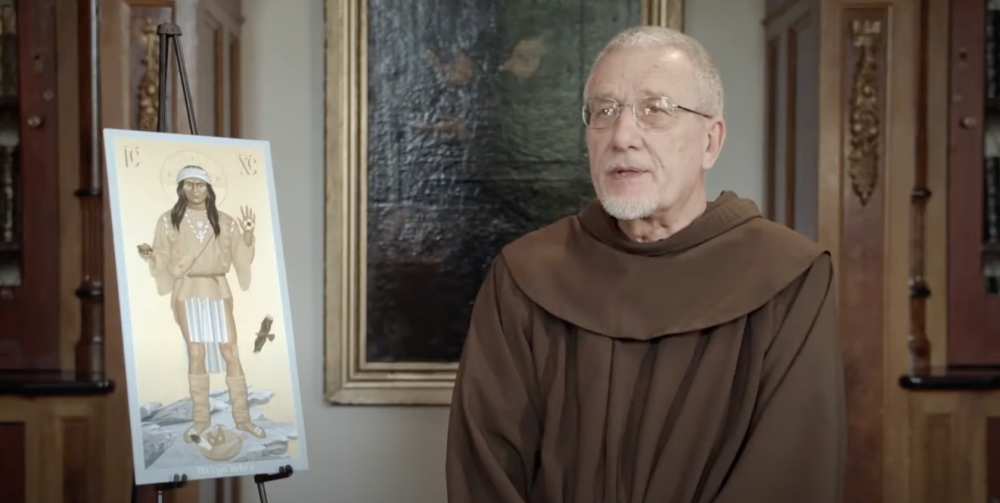Priest removes Indigenous art from New Mexico Catholic church, shocks parishioners

Robert Lentz with the icon he painted of Christ as a Mescalero holy man and gifted to the people of St. Joseph's Apache Mission. (Video screengrab)
Update: The removed icons have been returned as posted on the Mescalero Apache Tribe Facebook page: "It is with profound joy that we announce that the paintings taken from St. Joseph's Apache Mission have been returned to the tribe and will be returned to their locations in the church."
On June 30, parishioners and guests walked into St. Joseph’s Apache Mission in Mescalero, New Mexico, for the 10:30 a.m. mass as they have done for close to 100 years. The stately, cavernous church was full of people soberly taking their seats and filling the hall.
Missing from the hall were items significant to the Mescalero Catholics—ceramic Communion goblets gifted to the tribe by a New Mexico pueblo, hand-woven Apache baskets, a large painting of Apache dancers honoring veterans and, most noticeably, the 8-foot icon called the Apache Christ which has hung behind the altar since 1990. The painting is the work of Franciscan friar Robert Lentz and depicts Christ as a Mescalero holy man.
Those who entered the church that day were greeted by Apache women in full regalia handing out paper slips, similar to Monopoly money, for people to put into the collection baskets during services, because “we don’t want to support the diocese.”
Somewhere between Wednesday, June 26 and Thursday, June 27, someone had gone into the church and removed the paintings, including the Apache Christ. Many of those present Sunday regard this removal as a theft, claiming the Las Cruces Catholic Diocese, in the person of the church’s pastor, Peter Chudy Sixtus Simeon-Aguinam (known as Father Chudy), and the Knights of Columbus from Alamogordo had “stolen” the items.
“I gave it to the people, not to the diocese . . .,” Lentz said in a statement responding to the removal of the icon.
Anthony Salazar, state deputy of the New Mexico State Council of the Knights of Columbus, told the National Catholic Reporter any Knights of Columbus involved in the icon's removal “were acting on their own behalf” and "not . . . in the capacity of a Knight of Columbus.”
Following the mass, people were invited to speak to their concerns regarding the removal of the items. Ruta Shendo, chairman of the parish council, started the conversation with an overview of Simeon-Aguinam’s term since he was assigned to the parish in December 2023.
“I remember he had stated we as Apache people need to be self-sufficient and we need to be the ones running our church,” she said. “But he started, since December, pulling our cultural stuff from our church.”

As they leave church on June 30, parishioners at St. Joseph's Mission line up to sign a letter to the Los Cruces Catholic Diocese calling for the return of their items and the removal of their current priest. (Las Cruces Bulletin photo by Elva K. Österreich)
She said he had wanted to take down the Apache Christ or at least move it. The icon, she said, had been given to the parish, donated to the Mescalero people and not to the diocese, “but for some reason they believe it is theirs and they do not feel that it is fit to hang there.”
The pictures had been removed from their frames, which were left behind in a locked area of the church, she said.
“They made a comment that this is a church and not a museum, so they removed that picture against our will, saying it belongs to the diocese,” she said.
One of the parishioners, Anne Marie Brillante, had spoken by phone with Deacon John Eric Munson, following the removal of the items. She recorded and shared that conversation over social media platforms.
Munson, in the recording, told Brillante the painting had not been stolen, just removed with the help of the Knights of Columbus and the diocese chief property risk manager. He said it was done under the authority of Bishop Peter Baldacchino. When she said the items didn’t belong to them, he replied, “There is no such thing as the parishioners owning anything. . . . That parish is a corporation, just like all the parishes are corporations.”
When she asked where the paintings were, Munson told her, “It is not germane.”
Brillante also told Munson concerns voiced in the community about Simeon-Aguinam had not been addressed by the diocese.
During the June 30 gathering, Pamela Cordova, chair of the parish financial council urged those present to sign a letter as they left the church asking the bishop to return all artifacts that had been removed by Simeon-Aguinam and calling for the removal of Simeon-Aguinam himself.
“We would like to be served by a priest that wants to be here,” she said. “It got worse and worse. This is the last straw. I feel down to the depths of my heart the pain that we all feel.”
The items were removed from the church a couple of weeks following a June 14 document by US Catholic bishops approving a pastoral framework for Indigenous ministry.
“For over 100 years of Franciscan leadership . . . we were encouraged to believe that we are all created in the image of God,” Mary M. Serna, former retired director/administrator at St. Joseph Apache Mission Restoration Project wrote in response to the removal of the items.
“This does not seem to be the teaching of the current administration,” she continued. “Fr. Chudy has called us pagans and stated several times that the building is a church and not a museum. I guess he doesn't realize that it was built for the Apache people ‘to light their lives forever’ and as a veterans’ memorial.” — Los Cruces Bulletin





